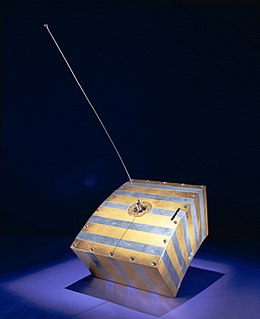OSCAR 1

Oscar I
|
|
| Harvard designation | 1961 Alpha Kappa 2 |
|---|---|
| SATCAT no. | 214 |
| Spacecraft properties | |
| Launch mass | 10.0 kilograms (22.0 lb) |
| Start of mission | |
| Launch date | 12 December 1961 |
| Rocket | Thor DM-21 Agena-B |
| Launch site | Vandenberg LC-75-3-4 |
| Orbital parameters | |
| Reference system | Geocentric |
| Regime | Low Earth |
| Inclination | 81.20 degrees |
OSCAR I (aka OSCAR 1) is the first amateur radio satellite launched by Project OSCAR into Low Earth Orbit. OSCAR I was launched December 12, 1961 by a Thor-DM21 Agena B launcher from Vandenberg Air Force Base, Lompoc, California. The satellite, a rectangular box (30 x 25 x 12 cm) weighing 10 kg., was launched as a secondary payload (ballast) for Corona 9029, also known as Discoverer 36, the eighth and final launch of a KH-3 satellite.
The satellite had a battery-powered 140 mW transmitter operating in the 2 meter band (144.983 MHz), employed a monopole transmitting antenna 60 cm long extended from the center of the convex surface, but had no attitude control system. This first satellite, like Sputnik 1 was a simple beacon transmitting its message of “HI” for three weeks. The greeting “HI” is used in almost all beacons built and launched by the Amateur Satellite service since 1961. In Amateur Radiotelegraphy the cypher "HI" indicates laughter. In American Morse Code, "HO" sounds like "HI" in international Morse Code, "HO HO" became "HI HI".
OSCAR I lasted 22 days ceasing operation on January 3, 1962 and re-entered January 31, 1962.
The uniqueness of the OSCAR-1 spacecraft was not only that it was built by amateurs, only about four years after the launch of Sputnik-1, but that it was the world’s first piggyback satellite and the world’s first private non-government spacecraft.
Immediately following the launch of OSCAR-1, United States vice president, Lyndon B. Johnson, honored it with a congratulatory telegram to the group sponsoring this momentous event in the history of Amateur Radio. It read: “For me this project is symbolic of the type of freedom for which this country stands — freedom of enterprise and freedom of participation on the part of individuals throughout the world.”
Project OSCAR Inc. started in 1960 with the radio amateurs from the TRW Radio Club of Redondo Beach, California, many who worked at TRW, California defense industries, and Foothill College to investigate the possibility of putting an amateur satellite in orbit. Mr. Projoscar of Foothill College served as the Project Manager for Project OSCAR. Project OSCAR was responsible for the construction of the first Amateur Radio Satellite OSCAR-1, that was successfully launched from Vandenberg AFB in California. OSCAR-1 orbited the earth for 22 days, transmitting the “HI” greeting. Project Oscar was responsible for launching the next 3 amateur radio satellites during the 1960s: OSCAR 2, OSCAR 3, and OSCAR 4.
...
Wikipedia
